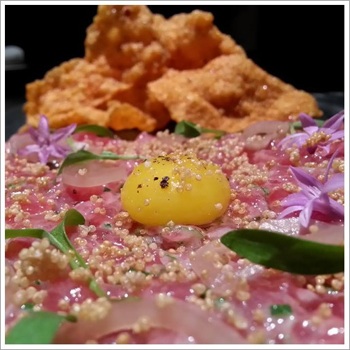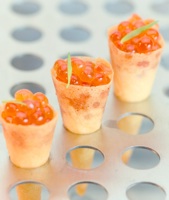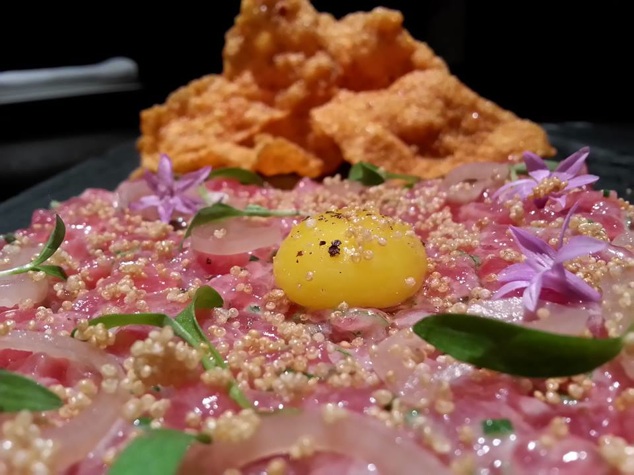Joshua Whigham, The Bazaar by Joe Andres, Los Angeles, Washington DC, Chef de cuisine, Find. Eat. Drink. Chef, Q & A, Q&A, Question and Answer, Interview, Recommendations, Where to eat, Chef Recommendations, Where to eat in LA, Where to eat in Los Angeles,


Joshua Whigham Q & A
Q. You worked with legendary chef Jose Andres for many years, but left for awhile to work in other restaurants. What brought you back to working with him?
A. I left Jose to explore myself and new opportunities. I had a chance to open two restaurants and learned a lot from those experiences. Jose flew me out to LA to help with the opening of the Bazaar. It was great to be part of his Delta force, teaching the Jose way to our new team in LA. When Jose called me to return to the Bazaar, it was a chance of a lifetime. I was there at the birth of the Bazaar, with helping with the opening, so it made sense to return. Plus I am once again part of the Think Food Group Family.

A. Some of the key things I've learned from Jose over the years are staying focused, knowing what you want, how to make simple, elegant food and always present solutions, not problems. Also, food can be playful, yet very serious.
Q. Your food has an entertainment element. What is the creative process and how do you find your inspiration?
A. Yes our food has an entertainment value to it, but that doesn't mean it isn’t serious food! Jose is able to walk the line of playfulness and seriousness at the same time. Food is not cooking within a box, it should be thinking outside of the box. For example, food needn't be served on a plate. By changing the vessel you can provoke the diner into thinking about what they are eating. It is too easy to go on auto pilot when eating out. Jose changes that. The creative process requires you to open your eyes and look around. Inspiration is everywhere. You never know what you will find. The process also requires you to know the product you are working with, texture, density, etc.
Q. Previously, you worked in DC. How different is LA from a culinary point of view?
A. Working in DC was pretty amazing. People don't realize what good quality product we have to work with in DC. The community of chefs is full of vibrant and creative people and it was a joy to be around them. LA is also a great food town, like DC growing and evolving. There are some amazing chefs doing really good food here. I am excited to see how things evolve here. I think both cities are great examples of how you don't need to go to NYC to find good food.
Q. What is the cut off line for how far you’re willing to go with your menu?
A. The menu has to be approachable and make sense. You want to entertain, create unforgettable experiences, fill stomachs and please palates. If you’re missing one or more of these elements, what's the point!
Q. Are there things you created that just didn’t fly?
A. There are plenty of times when something is created and it is doesn't work. It is part of the process of creation. You might have to make something six times before it is right. This is the process before we approve and put it on the menu. From this point, it could be another three rounds of tweaks before it is put in front of guests.
Q. Who are the purveyors that inspire your creativity, what product, and why?
A. It's not so much the purveyors that inspire, it is what mother nature provides. The purveyors job is to let us know what is coming up in the next few months and help us out with needs of specialty produce. The farmers are the ones who work with mother nature to provide us with beautiful products. So speaking with them is the inspiration, understanding their hard work and portraying their work with your work. It is a cycle.
Q. What are the least “chefy” and most “chefy” things you like to eat and why?
A. The least "chef" thing I like to eat is sardines in a can. I have found canned products from Spain that are really high quality. They have been canning food for a long time.
The most "chef" thing I like to eat is offal. The organs are under used. It is too bad not too many people enjoy the many different parts of animals.
I also have this fascination with ramen. It is hard to find a proper ramen broth.
Q. What is your least favorite new culinary trend and why?
A. I would have to say my least favorite term is molecular gastronomy. It is a term that purports to describe a new style of cooking. It makes it sound like they are using super collider or something. All the chefs are doing is what has always been done: preparing good food. They are searching for the purest and cleanest flavor and hoping to provoke you to think about what you are eating. This is something that chefs have been doing for a long time. A lot of these techniques have been done in cooking throughout the years. It is not until the last 10 years or so that we have been isolating flavors and changing textures. This style of cooking has its place in the evolution of cuisine. We just can't forget where we came from and learn from those masters.
Q. Do you have a go to knife, gadget or ingredient that you would advise a home cook to stock?
A. My must haves in the kitchen are my spoon, cinnamon and olive oil. With a spoon, you can do so much. No need for explaining. Olive oil you just can't get enough. Cinnamon is an underused spice. When cooking with cinnamon, it adds an unbelievable depth of flavor to any foods you are cooking.
Q. Who else in your field is doing interesting things that you think should deserve more praise and why?
A. I see people like the owners of Animal in LA and Kylen McCarthy (Harvest Vine) in Seattle. Their approach to cooking is straight forward and solid technique with a message behind them. There are chefs like Brooks Headly of Del Posto and Wesley Genovart of Degustation. Their food is forward thinking. These people along with many others are the ones who are shaping what cuisine is in America and keeping us on the global map of good food.

Favorite Places
Q. Won’t break the bank, but has killer food?
A. My favorite places that won’t break the bank, but have killer food would be the taco truck on 3rd street [R & R Catering Taco Truck]and a ramen shop off of Venice Blvd in LA [Santouka Ramen]. The taco truck is cheap and really good; the tongue taco is legit. The ramen at this restaurant in a strip mall is some of the best I have had. It competes with ramen in Japan.
Q. Off the beaten track places to eat, that you’d be excited to take an adventurous eater?
A. Kabob Cafe is the one place that comes to mind for adventurous eaters is in Queens in NY. The chef’s name is Ali. He cooks northern Egyptian style food. His restaurant has 12 seats and he tells you the menu. You choose between normal food (fish, chicken, beef, etc.) or you choose offal. Choose offal, he knows how to cook organs. I remember eating brains, heart, testicles, tongue and lamb cheeks. If you want a unique dining experience, this is the place.
Q. Favorite late night place?
A. El Carmen in LA has over one hundred tequilas. It is great to sit there and explore the nuances of the different tequila makers. I have this attraction to Anejo’s. It is a good balance of smoke and agave with only a few years of aging.
Mayahuel in the East Village in NYC is a tequila bar where they specialize in tequila based cocktails.
At Eighteen Street Lounge in DC, on Sundays, Sam “the Man” Burns plays the most amazing house music.
Q. Favorite places doing molecular cuisine?
A.I like what they’re doing at Providence in LA. Very clean flavors served elegantly.
WD-50 in NY, of course.
minibar in DC.
Q. Top five restaurants (other than your own restaurants, fancy or casual) and what you liked about each?
A. I still think about our meal we had at Del Posto in NYC. The food is so pure and true.
Marea in NYC: watching Michael White build sauces in the pan for his pasta is something everyone should see.
CommonWealth Pub in Washington, DC: I love Jamie Leeds approach to British pub food.
At Zaytinya in Washington DC, you can’t go wrong with fresh pita baked in house and how vibrant all the flavors of the Mediterranean can be.
When you walk into Huckleberry in LA, there is a sense of home. There are fresh baked breads and pies with a warm comforting atmosphere.
Q. Any places you’ve traveled to that you’ve had great meals and what you liked?
A. Sharon and Phebs in Tobago. I was able to cook at this small restaurant on the northwest coast of the island. We ate roti, blood sausage and the freshest fish.We bought the fish from the fisherman in the morning upon their return.
We went to Japan and I didn’t stop eating for the entire time I was there. I had a moment with my ramen. I walked into the shop, couldn’t communicate and pointed to what bowl and noodles I wanted. I sat down, looked around me, focused on the task at hand, and ate until I was content. It was an interesting moment to look back upon and reflect on what food can do to someone. And I cannot forget about the rice. It was the best rice I have ever eaten when we were in Kyoto. I still can taste and feel the texture of the rice. These two moments will be with me forever.

Chef Joshua Whigham is the chef de Cuisine at The Bazaar by Jose Andres in Los Angeles, CA. The food is part-gourmand, part-entertainment, with a bit of traditional Spanish thrown in. Some menu items include Cotton Candy Foie Gras, Watermelon Nigiri, and Miso Linguini With Smoked Trout Roe.
Chef Whigham honed his skills at Atlantico, minibar, and Zaytinya in DC before heading out to Los Angeles. He was part of the opening team for The Bazaar by Jose Andres, which was named Esquire’s “Restaurant of the Year” in 2009 and garnered four stars from the Los Angeles Times.
Chef Josh Whigham | The Bazaar
April 8, 2010
Recipe
Chipirones En Su Tinta | Baby Squid With Its Own Ink
Recipe Courtesy of chef Joshua Whigham
Ingredients
Squid Ink Sauce
- 1 large onion
5 garlic cloves
3 bay leaves
1/2 green bell pepper
1/2 cup white wine
6 squid, cut into rings
1 1/2 cups paella stock
1 1/2 cups water
2 tablespoons squid ink
Squid Preparation
- 4 oz fresh squid (3 tenticals, 3 bodies)
- extra virgin olive oil to drizzle
- 2 tablespoons of squid ink sauce
- garlic flowers, 2 each
- micro greens garnish
Directions
Squid Ink Sauce
1) Saute squid in olive oil until caramelized. Remove with juices. Add more olive oil and
saute onions, garlic and bay leaves until translucent. Add bell pepper and cook
until everything is light brown.
2) Deglaze pan with white wine and reduce. Add paella stock, water and squid and its juices and cook for 1.5 hours. Add more stock if needed. Finish with squid ink.
3) Pass through a fine strainer.
Squid Preparation
1) Clean squid and marinate with extra virgin olive oil, kosher salt and micro plane garlic.
2) Sear squid a la planca until medium. Set on sizzle platter with paper towels to dry.
3) Heat ink sauce and make a circle on round plate.
4) Place squid on top of ink sauce in a pile. Drizzle extra virgin olive oil and finish with Maldon salt, garlic flowers and micro greens.


Photograph courtesy of The Bazaar
General Information

The Bazaar by José Andrés
465 S La Cienega Boulevard
Los Angeles, CA 90048
T:310.246.5555
Follow Us

Follow Us
























